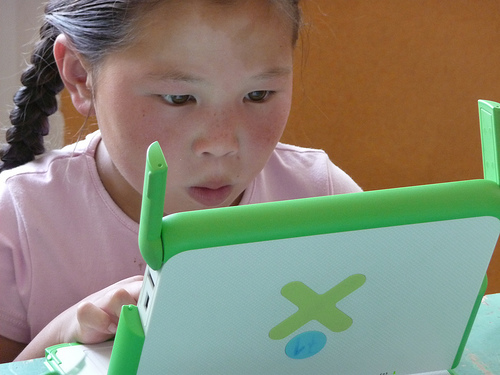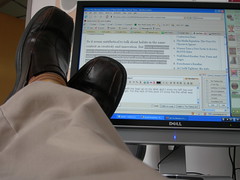
Can you become Creative?
A great article out of the New York Times entitled: Can You Become a Creature of New Habits? Has had me thinking today about creating creative cultures in our schools.
David Warlick wrote a post recently that looked at the top 25 economic cities in the U.S. and how a “creative class” played a role in the rankings.
What I found interesting was the Bob Cook, who evaluated the cities factored in the portion of the population (that) were in the creative class. This includes scientists, engineers, artists, and teachers. The belief is, and this is consistent with Richard Florida’s writings, the creative class benefits the economic prosperity of a community as well as culture.
So perhaps one of the challenges of communities today is, “How do we attract creative people?†“How do we convince our creative children to stay?â€
Or another question: How do we create creative people?
The authors and researchers quoted in the article has some interesting things to say.
“The first thing needed for innovation is a fascination with wonder,†says Dawna Markova, author of “The Open Mind†and an executive change consultant for Professional Thinking Partners.
Do we encourage our students to wonder? I see it all the time in Kindergarten classrooms, see it a lot in 2nd grade, not so much in 5th grade and by 8th grade? I don’t think I’ve ever hear a middle school or high school teacher say “I wonder…….”
Instead we ask students to make decisions. We as them to decide between this answer and that answer. We ask them to decide between fact and opinion.
“But we are taught instead to ‘decide,’ just as our president calls himself ‘the Decider.’†She adds, however, that “to decide is to kill off all possibilities but one. A good innovational thinker is always exploring the many other possibilities.â€
So by asking students to make decisions rather than wonder about possibilities we’re fitting students into the box of what we believe to be right or wrong.
The article goes on to talk about brain research and how habits play a role in our creative nature.
…brain researchers have discovered that when we consciously develop new habits, we create parallel synaptic paths, and even entirely new brain cells, that can jump our trains of thought onto new, innovative tracks.
 Now that’s cool. I’m sitting here with my legs up on my desk and I cross my left leg over my right. Why? Habit…it just feels right. For the rest of this post I’ll cross them the other way.
Now that’s cool. I’m sitting here with my legs up on my desk and I cross my left leg over my right. Why? Habit…it just feels right. For the rest of this post I’ll cross them the other way.
So we need to help students consciously develop new habits to stay creative. Think of the habits you could help students consciously develop in your classroom.
What if once a week students in your class had to write with the opposite hand. Just once a week for 40 weeks….new pathways?
What if as a teacher you consciously took a different route home from work. Making yourself pay attention to the road, to signs, etc.
In fact, the more new things we try — the more we step outside our comfort zone — the more inherently creative we become, both in the workplace and in our personal lives.
I wonder if that is part of the reason why educational technology people (for the most part) are a creative bunch. Most of us (myself included) started out as a classroom teachers and we tried new things with technology. We tried this tool, that website, we got creative to a point where today….heck, I try stuff just for the fun of it.
I have test sites set up where I try to break programs. I hack PHP script without thinking about it, yet four years ago I would have thought PHP to be a drug.
The current emphasis on standardized testing highlights analysis and procedure, meaning that few of us inherently use our innovative and collaborative modes of thought. “This breaks the major rule in the American belief system — that anyone can do anything,†explains M. J. Ryan
You mean to tell me we can’t test the creativity into students? That the current state of testing mandated by the government is counterproductive to creating innovative and collaborative people. The same skills that companies are looking for in new employees? (I’ll stop there)
Where are students allowed to be creative today. Art class is the first that comes to mind. Maybe it’s because my office is down the hall from the art room where music is blaring and kids take risks with every stroke of the brush. They wonder, they innovate, them try something new, learn, and try something new again. What about the performing arts? Students continually reinventing themselves for parts in a play, acting this way or that way that breaks the habits of what they know and who they are.
What about technology? Kids hack up their Myspace pages to create their own themes, they learn, create and produce their own videos for YouTube. They imagine then create their own avatars for online games. They take risks every time they play a computer game, they make decisions, learn the outcome, reevaluate and try again. They continually try new approaches, new methods until they find one that works for them. How many times have you been working on the computer or playing a game and thought to yourself:
I wonder what would happen if……..
How do we instill this wonder into our education system? Why do we not allow students to explore information, to reach their own conclusions by creating their own answers? Why is it so hard for us to become the schools we know we need to become?
I know…more questions then answers. But what did you expect….my legs are crossed the wrong way!







I highly recommend Sir Ken Robinsons book http://tiny.cc/96Y0R and talk about creativity at TED
Although my experience is predominantly at the post-secondary end of the education, I think wonder is recoverable in the application of traditionally staid classroom lessons in the actual world – I thought of a couple of books reading this post – David Abram’s Spell of the Sensuous in which he reintroduces wonder to a culture he sees largely detached from its world by scientific empiricism, and Mary Campbell’s Wonder and Science, which, though about early modern explorers, puts a finger on how the two are far from inseparable, but depend upon one another. Doing something – and doing it for ‘real’ – not with regard for disciplinary boundaries or test-based assessment, but just applying what students know – can be far more engaging, and full of wonder for both teachers and students – than traditional curricula.
Hi Jeff,
“I wonder” is the cornerstone of my 8th grade classroom-modeled and asked daily. I wonder what will happen if I continue this approach in the face of standardized testing?
I wonder if one teacher one year can make a difference?
I wonder if teachers like you that understand this are plentiful and just drug down by testing and day to day grind or if there really is that much retraining to do.
Thanks for the comment. 🙂
Well I don’t think I am alone. But, I have seen my share of students who have had the wonder taught out of them, whether through outdated and tired practices or systemic problems. What I have truly loved about the 8th grade is that I can still get it back, they are still kids who want to learn, explore and wonder.
You ask an interesting question. If you took a team of teachers and gave them license to innovate, freed them from the constraints of the testing culture, what would happen, what would they create? Would it be different? How replicable would this experiment be?
Jeff, I love the questions you ask in this post.
As a parent of TWO sons that are “twice exceptional” — as in gifted and having special needs — I can tell you that they both lose their creative streak during school.
It is not only the classroom environment, the “old school” teaching, the hectic pace of the daily routine, but it is the ridiculous notion that is continually imposed that we have to do it “this way” or “that way”.
Perfect example: My 15yo has been using Inspiration to take notes and draft reports since he was 8, when we first worked together on his report on the funnel web spider for third grade. This past fall, he had to write three different research papers for his AP English class — and the teacher INSISTED that he use filecards, written IN PENCIL. His IEP clearly states that he can and should use technology when it is available (and it was), but she didn’t care because she thought it was an important skill to teach. (Why should ANY child need an IEP to tell a teacher that he can and should use technology when it is available?!?!?) Had he been able to use the tools he knew, he would have color-coded his notes based on source, arranged and rearranged the ideas endlessly, and produced papers of a far higher quality than the ones done with filecards.
To drive the point in another direction, my boys are both authors and artists and composers of music — and talented, in the opinion of others besides their proud mom. During the school year, they struggle to find the mindset that allows them to create new work — a bit like “writer’s block” because all of the energy has been zapped out of them by school. They actually “steal time” when they are supposed to be doing homework (or when they are supposed to be sleeping) in order to “relax” by sketching, writing stories or making up new music.
When are they at their most creative? About two weeks into summer.
And then school starts again.
My daughters are in middle school, they have no time to interact, their creativity is in thinking of ways to piss the teachers off and keep straight A’s. My 8th grader took Spanish as one of her connections all through ms, the other one was randomly chosen for her, it was P.E. every time. I finally had enough of buying brand new tennis shoes and shorts every nine weeks and emailed the school to see about getting her some culture, I teach Art for Christ’s sake, it was killing me!! They finally put her in Tech Ed. On her writing assessment test, her topic was about why they don’t offer cooking classes in school? She got a perfect score on it, but I was thinking wasn’t that Home Ec back in our day???